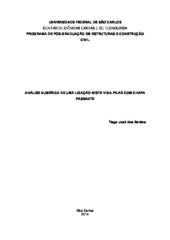| dc.contributor.author | Santos, Tiago José dos | |
| dc.date.accessioned | 2016-06-02T20:09:20Z | |
| dc.date.available | 2014-07-18 | |
| dc.date.available | 2016-06-02T20:09:20Z | |
| dc.date.issued | 2014-04-14 | |
| dc.identifier.citation | SANTOS, Tiago José dos. Numerical analysis of the behavior of a composite beamcolumn
connection with shear plate. 2014. 160 f. Dissertação (Mestrado em Ciências Exatas e da Terra) - Universidade Federal de São Carlos, São Carlos, 2014. | por |
| dc.identifier.uri | https://repositorio.ufscar.br/handle/ufscar/4693 | |
| dc.description.abstract | Among all of the existing structural systems, the steel-concrete composite elements outstands because it takes advantage of the properties of both materials in the same element. Unlike the system in reinforced concrete cast in situ, the steel-concrete composite system is not monolithic, and therefore the global behavior of the structure is mainly linked to the behavior of the connections. Currently, the beam-column connections have been the subject of theoretical and experimental studies to better understand their structural behavior. This concern has become even bigger with the introduction of requirements on steel-concrete composite connections in the Brazilian standard ABNT NBR 8800:2008. In order to contribute to this subject, in this work is studied by numerical modeling, a detail of a composite beam-column connection with shear plate using numerical models. The numerical analysis performed in the computer package ANSYS® was divided in two phases: validation of the numerical model from experimental results and subsequent parametric analysis. Despite of the simplifications adopted in the numerical simulation, the results were satisfactory and representative of the experimental behavior, especially for Force vs. Displacement at the end of the beam. Once validated the numerical model, a parametric study was conducted in order to evaluate the influence of some parameters on the bearing capacity of connections, such as the concrete slab reinforcement ratio, the slab thickness and the steel beam depth. The results of the parametric analysis showed that the variation of the slab thickness was the parameter with more influence on the bearing capacity of the composite connection with shear plate. | eng |
| dc.format | application/pdf | por |
| dc.language | por | por |
| dc.publisher | Universidade Federal de São Carlos | por |
| dc.rights | Acesso Aberto | por |
| dc.subject | Modelagem numérica | por |
| dc.subject | Análise paramétrica | por |
| dc.subject | Ligação com chapa passante | por |
| dc.subject | Ligação mista | por |
| dc.subject | Ligação viga-pilar | por |
| dc.subject | Composite connection | eng |
| dc.subject | Beam-column connections | eng |
| dc.subject | Numerical
modeling | eng |
| dc.subject | Parametrical analysis | eng |
| dc.subject | Connection with shear plate | eng |
| dc.title | Análise numérica de uma ligação mista viga-pilar com chapa passante | por |
| dc.title.alternative | Numerical analysis of the behavior of a composite beamcolumn
connection with shear plate | eng |
| dc.type | Dissertação | por |
| dc.contributor.advisor1 | Nardin, Silvana de | |
| dc.contributor.advisor1Lattes | http://lattes.cnpq.br/5587716781980132 | por |
| dc.description.resumo | Dentre os sistemas estruturais existentes destaca-se aquele formado por elementos mistos de aço e concreto. Este sistema utiliza as vantagens dos materiais estruturais mais utilizados na construção civil, o aço e o concreto, agrupando-os em um único elemento estrutural. Diferentemente do sistema em concreto armado moldado in loco, o sistema misto de aço e concreto não é monolítico e, portanto, o comportamento global da estrutura está principalmente atrelado ao comportamento das ligações. Atualmente as ligações viga-pilar têm sido alvo de estudos teórico-experimentais visando melhor compreender seu comportamento estrutural. No Brasil esta preocupação tornou-se ainda maior com a introdução de prescrições sobre ligações mistas de aço e concreto na norma brasileira ABNT NBR 8800:2008. Visando contribuir neste sentido, no presente trabalho é estudado, via modelagem numérica, um detalhe de ligação mista viga-pilar com chapa passante. A análise numérica realizada no pacote computacional ANSYS® foi dividida em duas etapas: validação do modelo numérico a partir de resultados experimentais com posterior análises paramétricas. Apesar das simplificações adotadas na simulação numérica, os resultados foram considerados satisfatórios e representativos do comportamento experimental, sobretudo da curva Força vs. Deslocamento na extremidade da viga. Uma vez validado o modelo numérico, o estudo paramétrico foi realizado com vistas a avaliar a influência de alguns parâmetros na capacidade resistente da ligação. Os parâmetros avaliados foram: taxa de armadura da laje de concreto, altura da laje e altura do perfil de aço da viga mista. Os resultados da análise paramétrica mostraram que a variação da altura da laje foi o parâmetro que mais influenciou na capacidade resistente da ligação mista com chapa passante. | por |
| dc.publisher.country | BR | por |
| dc.publisher.initials | UFSCar | por |
| dc.publisher.program | Programa de Pós-Graduação em Engenharia Civil - PPGECiv | por |
| dc.subject.cnpq | ENGENHARIAS::ENGENHARIA CIVIL::CONSTRUCAO CIVIL | por |
| dc.contributor.authorlattes | http://lattes.cnpq.br/2301103903408062 | por |
